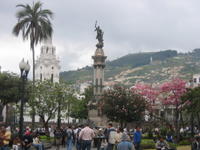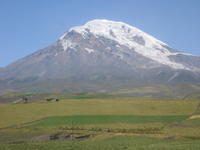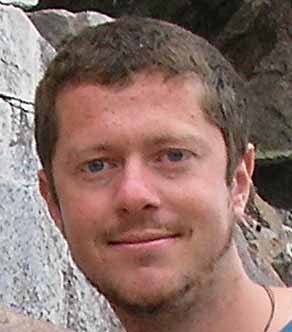Note: Most of the following content may be familiar to you; I apologize for being repetetive, it's just that now with Blog, I feel compelled to reshare the story with the accompaniment of photographs
To work out how long it takes to get from A to B on a map, I use my finger to measure up the scale, then the distance. I divide that figure by a reasonable 100kph.
Well, things don’t quite work that way in the Andes. The predicted 1 hour trip from the Colombian border to Quito, would take more than 5 hours. We had to break the journey down and stay in a town called Ibarra.
A Swedish guy on our bus was also going to Ibarra.Turns out my new friend was quite the adventurer.
Among being amazed by his tale of the Himalayas, I was equally surprised to learn that military service is mandatory in Sweden. Do they even have an army?
On that note of surprising European facts: would you believe Spain only abolished its death penalty in 1995. I was 15. The European Union for crying out loud. And this is well after Franco.
At 18, Eric realised that if he was to "waste" a year of his life in the army, he may as well make it worthwhile. He signed up for toughest of the tough. Arctic Ranger.
The countless nights out in the freezing, dark cold he plotted and schemed. When his service time was up he was going to do put his endurance skills to the test. Him and a fellow ranger went on the net to see what they could get up to in Nepal. They came across a Swedish Biker’s page who had cycled 1000km across the Himalayas from Tibet to Kathmandu. They set up a meeting.
The guy told them there were life or death complications involved, and not just from lack of oxygen, water, fatigue or getting lost. It was illegal to be in Tibet unless in a group and with a guide. And no guide, let alone group, would brave the 1000km journey they now had their hearts set on completing by foot.
If you manage to get into Tibet, the guy continued, there is the problem of getting past the Chinese checkpoints. If you are spotted, you WILL be a shoot to kill target. Simple as that.
The only resolve, they had the guy marked out the checkpoints on a map. They would have to use their army skills to sneak past them.
And so they got their sponsors, their parents worried as hell and at 19 years of age flew from Stockholm to the rooftop of the world. Sure enough they were arrested in Tibet, though more of a house arrest until the next flight would take them back to Nepal. They escaped and authorities well behind them began their one month voyage with two maps and a GPS.
They managed to sneak around the checkpoints at night. All those combat training sessions in the arctic circle had paid off.
Along the trail they skirted mount Everest and spent a night in the base camp. Here they met all the world professional climbers who were either on their way up or down Everest. Being professionals, they could tell just looking at these Swedes and their packs, that they were not climbers, merely "base camp tourists", (probably arrived by cable car or something).
When the camp found out what they were really up to they couldn’t believe it. The bravest men on Earth were looking at these two 19 year olds in awe. The teenagers were the heroes of the camp that night, not the guy who just came back with a Polaroid of him on the summit without an oxygen tank.
And there was me thinking I was on an adventure. What a copout I am. The next day I told Peter. He jumped out of bed, we went across to Eric’s room, and Peter told him to mark on a napkin where the Chinese checkpoints were.
 (Virgin on the hill)
(Virgin on the hill)
We were excited about arriving in Quito, somewhere we read that it had one of South Americas’s best Old Towns. We knew we’s arrived when we saw the big Virgin on the hill.
We weren’t disappointed, the old town was packed with colonial architecture. Without a guide or a map we wondered the cobbled streets inventing names for the squares and functions for the grand buildings.

(Old Town Quito)
The thing I was most excited about however was paying a visit to a very special museum.
Mitad del Mundo. The museum on the equator.
Everyone is taking their picture with one foot either side of the clearly marked YELLOW line coming from a monument, so they can show all the folk back home that they have stood simultaneously in both the northern and southern hemisphere.

(On the fake line)
Somehow we got wind of a few tricks that can be performed only on the equator. Something about balancing an egg on a nail? We were directed back to the entrance, and told to turn right for 100m and follow the signs to anther museum.

(Balancing an EGG on a nail)
Arriving onsite we notice another painted line running the length of this museum. Only this time the line was RED. Looking across the way, we could easily tell that the YELLOW and RED lines did not meet up.
Someone had to be lying and it had to be this out of the way, run down place.
"We are the true line", our new guide suddenly declares to us. "Allow me to prove it".
First off he explained that with modern day GPS there could be no doubt as to the location (even to one millimetre) of the line. The complex over the road, he continues, has been established since the French founded the line (or at least thought they had) back in the 17 hundreds. Though let us admit it: they did get pretty damned close! 
(Simultaneously in both Hemispheres)
Our tour guide brings us to a ready made portable sink. It's full of water, and there is a bucket underneath it. She takes us to a meter or so away from the RED line, onto a spot appropriately marked: NORTHERN HEMISPHERE. She calms the water with her hand, then opens up the plug hole, and we all witness the water going down the hole in a CLOCKWISE motion. She drops in a couple of small leaves to accentuate the whirlpool motion.
SO WHAT. We've all seen this before. Everyday back home.
Next she moves the whole operation to one meter the other side of the line onto a spot naturally marked: SOUTHERN HEMISPHERE.
Amazingly the water, again exaggerated by the help of leaves, exits the plug hole in a counter clockwise motion.
WHAT THE HELL. We'd just seen the exact opposite happen, as many minutes and meters ago.
That’s not all iterates the guide - watch this

(Peter simultaneously in both Hemispheres)
She then proceeds to move the sink and the bucket, placing it exactly over the line, so that the middle of the sink, the plughole, is in perfect alignment to the RED line. And it really happened.
The water went straight down the plughole. No mini whirlpool, no give from the leaf. Straight out.
The distance between the north and the south pole is some 20 000km, but the water goes straight down within the space of a single centimetre. And I can confirm it all happens within 1cm, even though the guides experiments were at a couple metres apart, I later went back and carried out my own experiments.
Surely this is the most amazing fact of life!!!!

(Mount Cotopaxi)
Back in England, Thaufik an Ecuadorian friend of mine, had given me a Cotopaxi T-Shirt. At just under 6000m it is one of the Earths tallest volcanos. A mere two hour trip from Quito, we made enquiries about visiting the national park. There were two types of visits. A day trip taking you as far up as 4850, which allowing you to see the beginning of the Glacier, also rings the novelty of being higher than anywhere in Europe.

(Higher than all of Europe)
The second, an overnight stay in the base camp, with a midnight scaling of the mountain, using crampons and ice-pick, bringing you to the freezing summit around 5-6am for the sunrise. A collection of reasons meant we could only do the day trip. To this day, still one of Peter’s greatest regrets.

(Me on the glacier)
At least we opted for the bicycle descent of Cotopaxi. We went so fast, we left our 4X4 a speck in the distance. We went so fast, you couldn’t avoid the rocks in the road, you simply had to ride them. We went so fast, that Peter once went clear flying off his bike. Though he appeared to have broken his leg, I couldn’t contain my laughter. Luckily he was ok.

(Peter on the Glacier)
With Peter flying back to Europe, I hooked up with Thaufik

(Thaufik)
He gave me a driving tour of the city, giving me the full perspective of this wondrous land of mountains. So far South America was one big mountain to me.  (Chimborazo)
(Chimborazo)
Next I was off to Peru. More mountains. And leaving Ecuador I passed its highest peak Chimborazo, among various other erupting volcanos.
(Errupting Volcanoes)

1 comment:
dnt worry jeremiah, stanzi's not the only one that reads the blogs.
Post a Comment